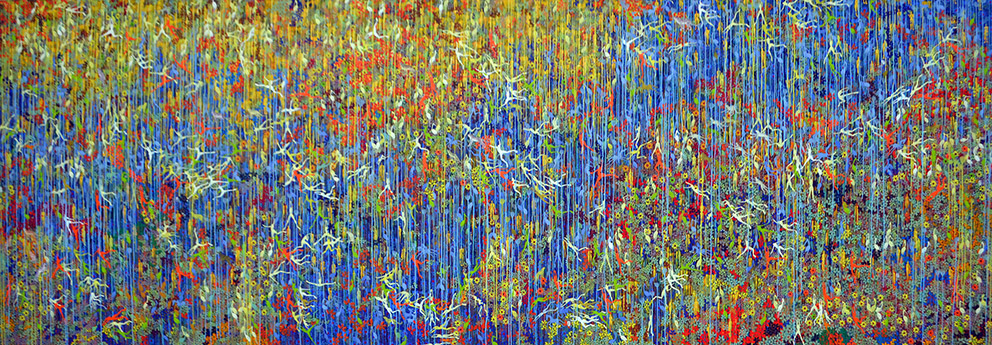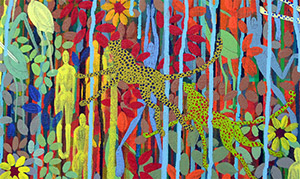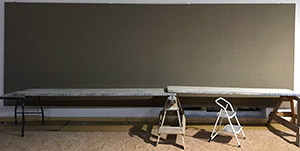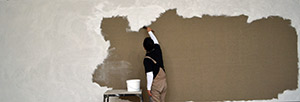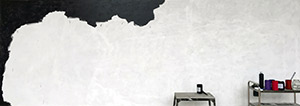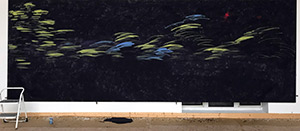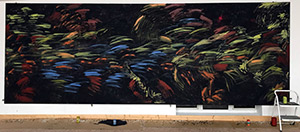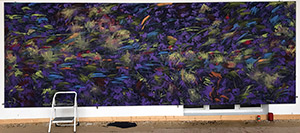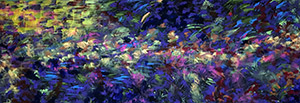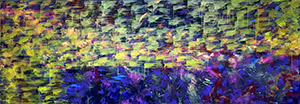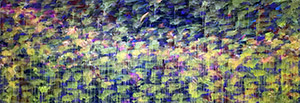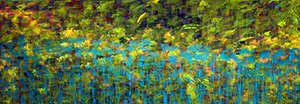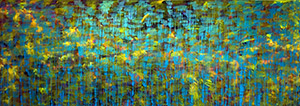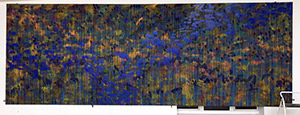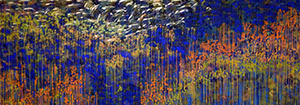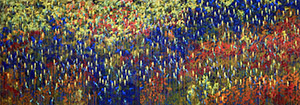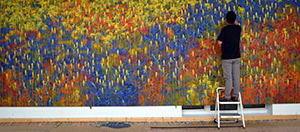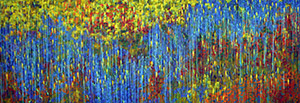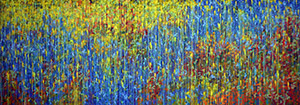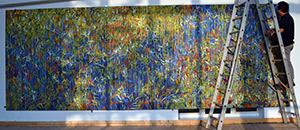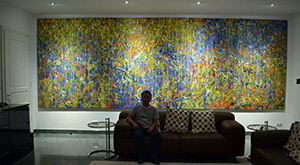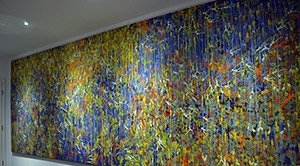German:
AUS DER DUNKELHEIT GEBOREN
Und die Erde war wüst und leer, und
es war finster auf der Tiefe;
[…] Es lasse die Erde aufgehen Gras
und Kraut, das sich besame, und fruchtbare Bäume, da ein jeglicher nach
seiner Art Frucht trage und habe seinen eigenen Samen bei sich selbst
auf Erden.
[…] Es errege sich das Wasser mit
webenden und lebendigen Tieren, und Gevögel fliege auf Erden unter der
Feste des Himmels.
(1 Mose, Gen 1,2.11.20)
Der Entstehungsprozess des überdimensional großen Gemäldes ZURAG 63 lässt an die biblische
Schöpfungsgeschichte denken, mit der Erschaffung der Erde, des Himmels,
der Meere, der Länder und allen Lebewesen. Auf sechs Metern Länge hat
der in der Mongolei geborene und in Berlin lebende Künstler OTGO (Otgonbayar Ershuu) in Zyklen und
über zwei Jahre (2017-2018) hinweg dieses bildnerische Paradies
geschaffen. Der Künstler nimmt uns nun mit auf eine Reise durch seinen
künstlerischen Kosmos, um einen Einblick in die Genesis dieses Gemäldes
zu gewinnen...
Aus der Dunkelheit - der Grundierung der Leinwand mit Karbonschwarz -
erwacht in ZURAG 63 ein
lichtdurchflutetes Paradies. Die Lichtquelle und fruchtbare Saat ist
hier die Farbe, mit deren Hilfe die gestalterischen Elemente auf dem
Bildträger zu „keimen“ beginnen: Grün für die Pflanzen, Blau für das
Wasser, Rot für die Früchte und Gelb für die wärmespendende Energie der
Sonne. Diese in luftig-lockeren Schichten aufgetragenen Farben sind wie
ein Nährboden für die unendliche Vielzahl von figurativen Formen, die
später auf der Bildfläche entstehen. Würde man eine dieser
Farbschichten als Momentaufnahme einfrieren und wieder aufdecken, dann
erschiene eine Malfläche, die an eines der Seerosengemälde von Monet
erinnert.
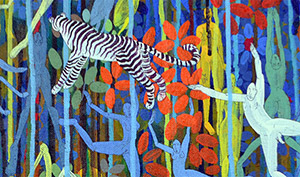 Detailansicht: ZURAG 63
Detailansicht: ZURAG 63
[…] Laßt uns Menschen machen, ein
Bild, das uns gleich sei, die da herrschen über die Fische im Meer und
über die Vögel unter dem Himmel und über das Vieh und über die ganze
Erde und über alles Gewürm, das auf Erden kriecht.
(1 Mose, Gen 1,26)
Bevor der Malgrund des Gemäldes „bewohnt“ wird, ziehen die Jahreszeiten
und Naturgewalten durch das Bild. Der Künstler versinnbildlicht dies
durch die Wahl der Farben und der Technik des Farbauftrags. Otgo
beträufelt die Leinwand immer wieder mit wässriger Acrylfarbe.
Monsunartig überströmt ein Blau das Bild und lässt Formen untergehen
und neue erblühen. Ein zyklisches Werden und Vergehen schreibt sich
mittels Spuren des Ausspülens und Überlagerns von Formen und Farben in
die Leinwand ein. So wie der Künstler einst von seinem Meister gelehrt
wurde, seine aufwendig und minutiös gemalten Thangka-Malereien sofort nach der
Fertigstellung wieder zu zerstören, durchläuft der Künstler dieses
Prinzip nun wieder und wieder und bereits während des langen Arbeitsprozesses
an diesem Gemälde.
Mit der Zeit lagern sich die zahlreichen Farbschichten wie in einer
geologischen Formation auf dem Bildträger ab und formen allmählich eine
Landschaft, mit einem Flusslauf, Bergen und Tälern. Das Bild gewinnt an
Perspektive und offenbart einen Blick in die Tiefe, durch die Lianen
des Farbdschungels hindurch.
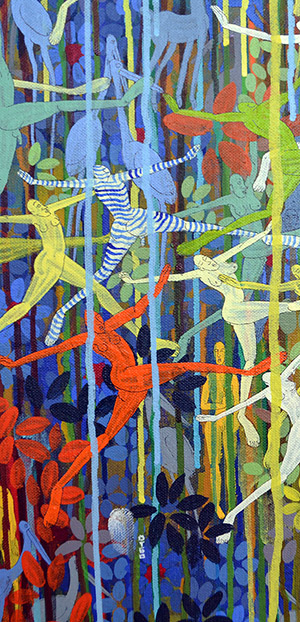 Detailansicht: ZURAG 63
Detailansicht: ZURAG 63
Und Gott schuf den Menschen ihm zum
Bilde, zum Bilde Gottes schuf er ihn; und schuf sie einen Mann und ein
Weib.
(1 Mose, Gen 1,27)
Was sich nun nach und nach aus der Tiefe des Dschungels dem Betrachter
zeigt, sind präzis gemalte Motive wie Blumenblüten, Pflanzen, Tiere,
und menschliche Figuren. Letztere tummeln sich in energetischen Strömen
und – aus der Nähe betrachtet - tänzelnd, fallend, reitend, schwimmend
oder schwebend durch das Dickicht der Farbe und über den gesamten
Bildträger. Sie finden sich dabei in einer friedlichen Gesellschaft von
Pelikanen, Pferden und Wildkatzen wieder. Die androgyn gestalteten
Körper der menschlichen Figuren erfahren erst spät durch die
zeichnerische Hand des Künstlers eine Geschlechterdifferenzierung.
Manche Wesen bleiben sogar geschlechterlos oder verschmelzen in der
Struktur ihres Inkarnats mit dem Fell der Tiere.
Hier lässt sich ein Zeitgeist von Genderdebatten und Umweltschutz
ablesen, oder ein neuartiger Blick auf den Menschen, ja auf alle
Lebewesen. Der Künstler fokussiert das Ursprüngliche und Wesenhafte an,
und geht zu jenem Ursprungsbild zurück, das die Verbindung aller
Lebewesen betont. Vor diesem Hintergrund können Vers 26 und 27 der Genesis kritisch
gelesen werden.
Es werde Licht! und es ward Licht.
(1 Mose, Gen 1,3)
Die Reise durch den bildnerischen Kosmos Otgos führte den Betrachter aus der
Dunkelheit in eine Fülle, in ein wohlig warmes Meer aus Formen und
Farben. Die Reise verhilft jedoch auch zu der antagonistischen
Erkenntnis, dass es bei solch einer Fülle schier unmöglich ist, jemals
alles zu sehen. Es ist eine Reise, die niemals enden wird, ...
